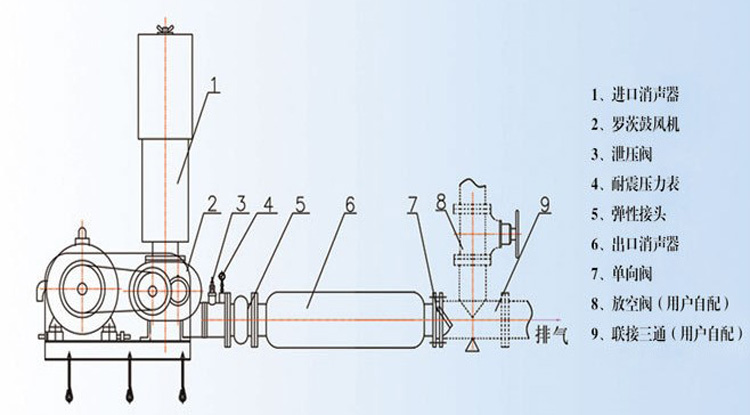Anatomy diagram of Roots blower

Roots blower is a commonly used positive displacement fan, and its anatomical diagram can clearly show its internal structure and the relationship between various components. The following is an anatomical diagram and explanation of the Roots blower, compiled based on relevant information:
Anatomy diagram of Roots blower
(Note: As actual images cannot be directly displayed here, the anatomical structure of the Roots blower will be described in text below.)
Roots blower is mainly composed of casing, impeller, driving shaft, driven shaft, gear, bearing, oil seal and other components.

1. Shell: It is the main part of a Roots blower, usually made of cast iron or steel plate, with sufficient strength and rigidity to withstand the internal pressure and external loads of the blower.
2. Impeller: It is a key component of Roots blower, usually made of aluminum alloy or cast iron, with two or three blades and gaps between them to ensure that they do not collide with each other during rotation.
3. Drive shaft and driven shaft: Connect the drive impeller and driven impeller respectively, and support them inside the casing through bearings. The driving shaft is usually driven by an electric motor or diesel engine, which drives the driven shaft and impeller to rotate together.
4. Gear: used to connect the driving shaft and the driven shaft, ensuring that the two impellers can rotate synchronously and in reverse. Gears are usually made of high-strength alloy steel, which has sufficient wear resistance and impact resistance.
5. Bearings: used to support the driving shaft and driven shaft, reduce friction and wear, and ensure the smooth operation of the fan. Bearings are usually either rolling bearings or sliding bearings, depending on the specifications and operating environment of the fan.
6. Oil seal: used to ensure the sealing performance of the fan when gear oil leaks into the interior or external environment of the casing. Oil seals are usually made of rubber or plastic and have sufficient elasticity and wear resistance.
Working principle of Roots blower
The working principle of a Roots blower is to use two synchronously rotating impellers to form a sealed chamber inside the casing, and to continuously change the volume of the chamber to suck in, compress, and discharge gas. When the impeller rotates, gas is drawn into the chamber and compressed and discharged as the impeller rotates. Due to the clearance between the impellers, even long-term operation will not cause wear on the rotor.
matters needing attention
1. When using a Roots blower, the oil level and quality of the gear oil should be checked regularly to ensure that the gears are well lubricated.
2. Regularly check the wear of bearings and replace severely worn bearings in a timely manner.
3. Pay attention to keeping the interior of the chassis clean and dry, and avoid dust and moisture from entering the interior of the chassis.
4. When starting and stopping the fan, follow the prescribed operating steps to avoid damage to the fan.
Through the above anatomical diagram and its explanation, one can clearly understand the internal structure of the Roots blower and the relationships between its various components, as well as the working principle and precautions of the blower. This helps to use and maintain Roots blowers, ensuring their long-term stable operation.





